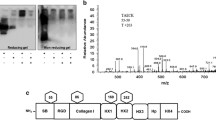Abstract
Background
Proteoglycans (PGs) are important constituents of the plasma membrane and of the basement membrane supporting the endothelial cell layer. Changes in the amounts or the structures of PGs in the endothelium may affect important functions such as turnover of lipoproteins, filtration properties, and regulation of chemokines during inflammation, which are all relevant in diabetes.
Aim of the study
The purpose of this study was to investigate if hyperglycemic conditions would affect the biosynthesis and secretion of PGs in cultured primary human endothelial cells.
Methods
Primary human umbilical cord vein endothelial cells were established and cultured in vitro. The cells were cultured either in medium with low glucose (LG) (1 g/l) or high glucose (HG) (4.5 g/l). From day 3–4 cells were labeled with 35S-sulfate for 24 h. 35S-Labeled macromolecules (medium) were purified by gel chromatography, and isolated macromolecules were analyzed by gel chromatography after different types of treatment, electrophoresis, and immunoprecipitation.
Results
Lower levels of secreted PGs were found in human endothelial cells exposed to HG. The major part of the PGs released was of the heparan sulfate (HS) type, and immunoprecipitation experiments showed that one such PG was syndecan-1. However, there was no difference in the ratio between HS and chondroitin sulfate (CS) under the different experimental conditions. Further, the PGs expressed neither differ with regard to molecular size of the glycosaminoglycan (GAG) chains, nor were their polyanionic properties affected by the different experimental conditions.
Conclusion:
The results obtained suggest that treatment of primary human endothelial cells with hyperglycemia leads to a decrease in PG secretion in primary cultures of human endothelial cells.





Similar content being viewed by others
References
The Diabetes Control, Complications Trial Research Group (1993) The effect of intensive treatment of diabetes on the development and progression of long-term complications in insulin-dependent diabetes mellitus. N Engl J Med 329:977–986
Yamagishi S, Imaizumi T (2005) Diabetic vascular complications: pathophysiology, biochemical basis and potential therapeutic strategy. Curr Pharm 11(18):2279–2299
Brownlee M (2001) Biochemistry and molecular cell biology of diabetic complications. Nature 414:813–820
Selleck SB (2000) Proteoglycans and pattern formation: sugar biochemistry meets developmental genetics. Trends Genet 16(5):206–212
Kjellen L, Lindahl U (1991) Proteoglycans: structures and interactions. Annu Rev Biochem 60:443–475
Kolset SO, Salmivirta M (1999) Cell surface heparan sulfate proteoglycans and lipoprotein metabolism. Cell Mol Life Sci 56:857–870
Miner JH (1999) Renal basement membrane components. Kidney Int 56:2016–2024
Saku T, Furthmayr H (1989) Characterization of the major heparan sulfate proteoglycan secreted by bovine aortic endothelial cells in culture. Homology to the large molecular weight molecule of basement membranes. J Biol Chem 264:3514–3523
Iozzo RV (1998) Matrix proteoglycans: from molecular design to cellular function. Annu Rev Biochem 67:609–652
Rops AL, van der Vlag J, Lensen JF, et al. (2004) Heparan sulfate proteoglycans in glomerular inflammation. Kidney Int 65:768–785
Wang L, Fuster M, Sriramarao P, Esko JD (2005) Endothelial heparan sulfate deficiency impairs l-selectin- and chemokine-mediated neutrophil trafficking during inflammatory responses. Nat Immunol 6:902–910
Bollineni JS, Alluru I, Reddi AS (1997) Heparan sulfate proteoglycan synthesis and its expression are decreased in the retina of diabetic rats. Curr Eye Res 16:127–130
Laffont I, Shuvaev VV, Briand O, et al. (2002) Early-glycation of apolipoprotein E: effect on its binding to LDL receptor, scavenger receptor A and heparan sulfates. Biochim Biophys Acta 1583:99–107
Vogl-Willis CA, Edwards IJ (2004) High-glucose-induced structural changes in the heparan sulfate proteoglycan, perlecan, of cultured human aortic endothelial cells. Biochim Biophys Acta 1672:36–45
Deckert T, Feldt-Rasmussen B, Borch-Johnsen K, Jensen T, Kofoed-Enevoldsen A (1989) Albuminuria reflects widespread vascular damage. The Steno hypothesis. Diabetologia 32:219–226
Jensen T (1997) Pathogenesis of diabetic vascular disease: evidence for the role of reduced heparan sulfate proteoglycan. Diabetes 46(Suppl 2):S98–S100
Kjellen L, Bielefeld D, Hook M (1983) Reduced sulfation of liver heparan sulfate in experimentally diabetic rats. Diabetes 32:337–342
Ha TS, Song CJ, Lee JH (2004) Effects of advanced glycosylation endproducts on perlecan core protein of glomerular epithelium. Pediatr Nephrol 19:1219–1224
Vogl-Willis CA, Edwards IJ (2004) High glucose-induced alterations in subendothelial matrix perlecan leads to increased monocyte binding. Arterioscler Thromb Vasc Biol 24:858–863
Shively JE, Conrad HE (1976) Formation of anhydrosugars in the chemical depolymerization of heparin. Biochemistry (Mosc) 15:3932–3942
Jarvelainen HT, Kinsella MG, Wight TN, Sandell LJ (1991) Differential expression of small chondroitin/dermatan sulfate proteoglycans, PG-I/ biglycan and PG-II/decorin, by vascular smooth muscle and endothelial cells in culture. J Biol Chem 266:23274–23281
Edwards IJ, Wagner JD, Vogl-Willis CA, Litwak KN, Cefalu WT (2004) Arterial heparan sulfate is negatively associated with hyperglycemia and atherosclerosis in diabetic monkeys. Cardiovasc Diabetol 3:6
Nugent MA, Iozzo RV (2000) Fibroblast growth factor-2. Int J Biochem Cell Biol 32:115–120
Garin EH, Shirey AJ (1988) Glomerular basement membrane heparan sulfate glycosaminoglycan in aminonucleoside of puromycin nephrosis. Child Nephrol Urol 9:121–126
Sorensson J, Bjornson A, Ohlson M, Ballermann BJ, Haraldsson B (2003) Synthesis of sulfated proteoglycans by bovine glomerular endothelial cells in culture. Am J Physiol Renal Physiol 284:F373–F380
Borrebæk J, Prydz K, Fjeldstad K, et al. (2001) The AGE product N epsilon-(carboxymethyl)lysine serum albumin is a modulator of proteoglycan expression in polarized cultured kidney epithelial cells. Diabetologia 44:488–494
Osawa T, Kato Y (2005) Protective role of antioxidative food factors in oxidative stress caused by hyperglycemia. Ann NY Acad Sci 1043:440–451
Way KJ, Isshiki K, Suzuma K, et al. (2002) Expression of connective tissue growth factor is increased in injured myocardium associated with protein kinase C beta2 activation and diabetes. Diabetes 51:2709–2718
Acknowledgments
This work was supported by grants from Helse og Rehabilitering, Norges Diabetsforbund, and the Throne Holst Foundation.
Author information
Authors and Affiliations
Corresponding author
Rights and permissions
About this article
Cite this article
Gharagozlian, S., Borrebæk, J., Henriksen, T. et al. Effect of hyperglycemic condition on proteoglycan secretion in cultured human endothelial cells. Eur J Nutr 45, 369–375 (2006). https://doi.org/10.1007/s00394-006-0608-9
Received:
Accepted:
Published:
Issue Date:
DOI: https://doi.org/10.1007/s00394-006-0608-9




